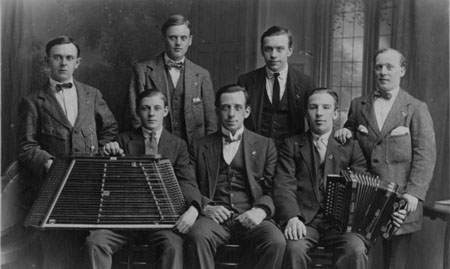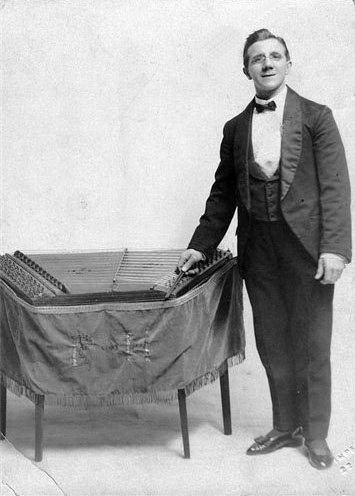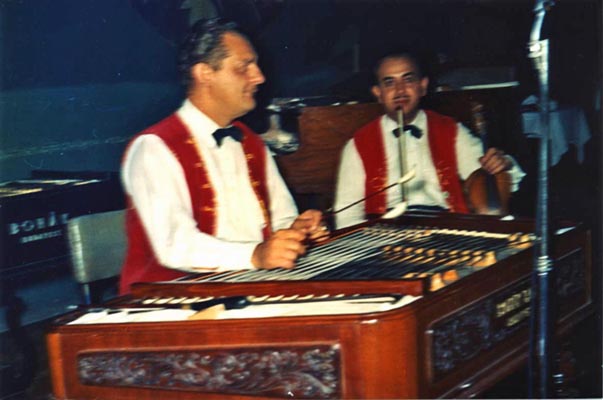DULCIMERS OF VARIOUS ETHNIC TRADITIONS IN NORTH AMERICAThe other pages on this site focus on the dulcimer that was popularized in the United States during the mid-19th century and taken up by people of various ethnic backgrounds then living in the country. In that sense, the "American" variety is pan-ethnic, yet at the same time it was concentrated mainly in certain areas and generally associated with rural people mostly of Colonial ancestry. However, other immigrant groups brought various dulcimer relatives to the United States and Canada. The purpose of this page is not to discuss these various musical traditions comprehensively, but to describe a limited number and compare their musical function, especially as it relates to the use of the instrument as an accompanying instrument. In terms of numbers of players, the largest ethnic traditions are those of the Volga Germans and the Ukrainians. The first group consists of descendants of Germans that Catherine the Great, Empress of Russia, invited in the 1760s to settle and colonize newly acquired lands near the Volga River. These Germans established agricultural colonies and villages and maintained German customs and language until they began to emigrate to America in the 1870s. Their emigration increased until 1914. In America, they settled as wheat farmers and sugar-beet workers in Kansas, Colorado, Nebraska, California, Michigan, Wisconsin, and elsewhere. In 1941, Stalin liquidated the settlements on the Volga and exiled the population to Kazakhstan. The survivors subsequently lost many of their distinctive customs as they became Russified. Immigration to these Volga colonies was open only for a few years in the 1760s and it stopped. With little contact with Germans in the homeland, their culture preserved much of the original culture of the founders. In Germany itself the dulcimer (called Hackbrett and Zimbal) largely died out in the 19th century. The Volga Germans, however, preserved elaborate wedding customs, including music for dancing that typically consisted of one or two violins, dulcimer, and bass, in later years with the addition of a clarinet or trumpet. In America, they preserved this instrumentation, although the violin gave way to the piano accordion, and other stringed instruments were dropped in favor of wind instruments. Yet the dulcimer survived the changes, and it graces the distinctive polka sound known as "Dutch Hop." "Dutch Hop" music is mainly found in northern Colorado and neighboring Nebraska. Some groups began making records in Denver in the 1940s, and they created standards that American-born generations have followed. In Kansas and the other areas in which the Volga Germans settled, the repertoire is somewhat different. In the smallest communities, like the Saginaw River Valley in Michigan, the music did not survive past the immigrant generation. In the moutainous region of western Ukraine, the dulcimer (tsymbaly) plays a prominent role in the wedding rituals of the Hutsul peasants. Along with violin, fipple flute (sopilka), and bass drum, the tsymbaly (held by a neck strap) follows the bride and groom from their homes to the church and back. Ukrainians settled in the bituminous regions of northeastern Pennsylvania and elsewhere in the United States, but they immigrated extensively to western Canada (mainly Manitoba and Alberta), where they purchased farms. These rural migrants maintained their wedding customs and made tsymbaly in their new home. According to Brian Cherwick, the tsymbaly became important as an ethnic symbol for the Ukrainians of Western Canada. It has been part of numerous bands making recordings which are broadcast on radio stations. The third most important immigrant tradition is that of the Hungarian cimbalom. This instrument has been an essential part of Hungarian Gypsy ensembles since the 18th century, and in the late 19th century Jozsef V. Schunda and other manufacturers made improvements to it so that it was acceptable to the country's middle class. Gypsy musicians and their families immigrated to the United States from Hungary and what is now Slovakia between 1885 and 1914, bringing their instruments with them. In addition, the popularity of Gypsy music among Hungarians during this period caused many other immigrants from Hungary and Slovakia, including several Jewish musicians, to take up the instrument. Greeks also adopted it. Players ordered the instruments from Hungary, bought them from makers in the United States, and made them themselves. The cimbalom has severely declined in the last fifty years as an ethnic instrument, but has gained advocates in recent years as an instrument used by professional percussionists and other musicians. Although historically an important instrument in their wedding ensembles, the tsimbl was already in decline during the wave of immigration of Jews from Eastern Europe. Nevertheless, several players emigrated, mainly to New York City. These included some from Galicia, Hungary, and Romania. The instrument did not survive past the immigrant generation, but in recent years, with the revival and development of klezmer music, it has witnessed a revival. Large numbers of Greeks came to the United States following the displacement of people as a result of the Balkan Wars and World War I, and they brought the sandouri (then at the height of its popularity) with them. Immigrants made them and musicians in Greek nightclubs played them, as well as the Hungarian cimbalom. After 1950, however, fashions changed and the instrument declined. With rare exception, it did not survive past the immigrant generation. The yangqin was very popular in southern China, from where most Chinese in the United States came. In Chinese communities, the instrument has been heard since the 19th century. However, given the nature of Chinese immigration, the instrument has not been domesticated in the way that some of the ethnic dulcimers mentioned above have. Recent immigrants have included a number of musicians who have graduated from the conservatories in China. 
Emigrants from England, Scotland, and Ireland brought dulcimers with them. A wagon train full of recent Mormon converts from England heading to Utah in 1847 featured a dance to a violin and dulcimer. After World War I, an industrial depression around Glasgow caused many to emigrate, bringing their dulcimers (at the time a popular instrument) with them. Sometimes a second generation took up the instrument, as in Utah, or in Iowa, where Thomas Mann, recorded for the Library of Congress in 1937, lived. Besides the groups mentioned above, one might also mention immigrants from Switzerland and Austria, Bohemia, Romania, and Armenians from Turkey. The following recordings have been chosen to represent the dulcimer of some of these immigrant traditions used as an ensemble or accompanying instrument.
Recordings
Volga German1. Old Dutch Polka played by David B. Dumler, violin, accompanied by Henry Ruppel, dulcimer, with dubbed-in electric bass. Recorded probably in Russell, Kansas, perhaps about 1960. I made a tape copy from Mrs. Henry Maser's copy in 1975. Dumler (1890-1972) was a fiddler and dulcimer player who came to Kansas as an infant. He attended fiddlers' contests, and he was the only dulcimer player many at those contests had seen. 2. Waltz played by Henry Maser, violin, accompanied by Alex Eckardt, dulcimer, and Edward Maser, guitar, recorded at Au Gres, Michigan, about 1965, copied in 1975. Maser (1904-1966) and Eckardt (1900-1976) were both born in Russia but came to the United States as children. 3. Polka played by Henry Maser, violin, accompanied by Alex Eckardt, dulcimer, and Edward Maser, guitar, recorded at Au Gres, Michigan, about 1965, copied in 1975. 4. Farmer's Waltz played by the Nile Valley Boys (Jake Haun, violin; Ed Kufeldt, piano accordion; Robert Meter, dulcimer; Ted Kufeldt, bass; Fred Weideman, baritone horn; Art Kufeldt, guitar). Electronic Recording Studio, Denver, Colorado, late 1940s. Dutch Hop Series 4-B. This is one of the first records made in the emerging "Dutch Hop" style of Northern Colorado and nearby Nebraska. The Nile Valley Boys, later known as the Polkateers, formed around the Kufeldt brothers, born in Nebraska of parents who had come from Russia. They played for weekly dances and weddings, which at this time lasted two or three days. Jake Haun (1892-1975) represents the generation of most of the band's parents. The violin has since disappeared from Dutch Hop bands. Scottish5. Unnamed tune played by Johan Henderson, mouth organ, accompanied by Peter Henderson, dulcimer, recorded at Coloma, Michigan, October 1975. Peter Henderson (1900-1976), a native of Inverness, Scotland, learned the dulcimer from his father. He came to Chicago in 1923 without the dulcimer, and made one there from memory. Johan (1899-1990), his wife (also an immigrant from Scotland), learned to play it, and they played dulcimer duets as well as duets on these instruments. 6. Unnamed tune played by Johan Henderson, mouth organ, accompanied by Peter Henderson, dulcimer, recorded at Coloma, Michigan, October 1975. Henderson called this accompaniment style "vamping." 
7. Leaving Glen Urquhart (march); Inverness Gathering (quickstep) played by Donald Cumming (button accordion, or melodeon, in British usage) and Eddy Holmes, dulcimer (Scotch Serenaders), recorded at Boston, November 17, 1934. Decca 14015A. Little for certain is known of Cumming, but Glasgow native Holmes immigrated in 1923 and worked as a machinist in Boston. This style of music was commonly heard at Scottish-American immigrant affairs during this period. When played with another instrument, the dulcimer usually "vamped." It is tempting to suggest that it was a survival of the style of Irish playing during the period 1770 to 1830, when the dulcimer was frequently paired with the fiddle. Czech (Moravian)-American8. Hezoučka mařka (polka) played by Bačova Česka Kapela (Baca's Czech Band), recorded at San Antonio, Texas, about June 1930. Columbia 161F. The Baca family, whose progenitor came to Fayetteville, Texas, from Moravia in 1860, had a remarkable history as having a family band for over a century. They used the cimbal, or dulcimer, as they called it, as a part of their music, which by this time consisted mainly of reed and brass instruments. The dulcimer follows the melody closely. Hungarian Gypsy9. Babonas két szép szemednék (Your fascinating eyes) played by Louis Rigo's Gypsy Orchestra, recorded at Camden, New Jersey, January 21, 1926. Victor 78597B. Louis Rigo, 1st violin, ?Joseph Rigo, 2nd violin, unknown ?viola, cello, cimbalom, and bass. This is a hallgató, a sentimental song in parlando-rubato style, appropriate as listening music in restaurants. Louis Richko or Rigo (b. 1899), younger brother of Joseph (1887-1956), came to America from Slovakia as a child. He led orchestras in Uniontown, Pennsylvania, and Cleveland. The cimbalom provides a harmonic foundation, with arpeggios, flourishes, and counter-melodies. All play by ear. 
10. Szegszárdi csárdás played by Gypsy orchestra led by Miska Bandy and Gus Horvath, recorded about 1950 at Pittsburgh, Pennsylvania. NRM 301A. Two violins, viola, cello, bass, and cimbalom. Bandy (1889-1958), born in Drienov, Slovakia, settled before 1910 in Youngstown, Ohio, later living in Braddock, Pennsylvania, before settling in Detroit. Gus Horvath (1916-2001), born in Whiting, Indiana, but raised in Uniontown, Pennsylvania, came to Detroit permanently in 1939. At that time, there numerous restaurants and bars along Jefferson Avenue in the Hungarian enclave of Del Ray, where the hard-working, relatively prosperous customers demanded Gypsy music. Even in the late '50s one could find four cimbaloms in these places. This caused many Gypsy musicians to move to Detroit from Pennsylvania and Ohio. The last nightspot closed in 1988. 11. Volt nekem egy szép csillagom (Once a Lovely Star Was Mine); Elment a rózsam Amerikába (Off to America My Love Has Sailed) played by Gypsy orchestra led by Miska Bandy and Gus Horvath, recorded about 1950 at Pittsburgh, Pennsylvania, NRM 300A. A hallgato followed by a csardas. Romanian12. Lume, de ce esti rea! (People, why are you bad!) spoken as an interlude by Ion Ionescu-Ardeal between doinas played by Alexandru Fodor, violin, accompanied by Victoria, cimbalom. Recorded in Chicago, 1927. Ardyal 7B. Fodor was presumably the laborer at Inland Steel Company who lived in East Chicago in 1918 and 1930 and was born in 1882 in Romania. Victoria Hanzi (1902-1949) was the daughter of Salamon Hanzi (1878-1938), a lautar from Transylvania who played violin and cimbalom. She married Steve Fodor (1896-1956), presumably related to Alexandru. They lived in the East Chicago-Hammond area of the Calumet region in Indiana and may have provided the music at a Romanian ball held above a saloon on Milwaukee Avenue in Chicago that Irving Brown describes in Gypsy Fires in America (1924). Ionescu-Ardeal was a singer and actor who performed for the Romanian communities in America. It was unusual in Europe for women to be instrumentalists, but in America the need for musician fathers to increase income led them to encourage their daughters to play. The Hungarian-Jewish musician Benjamin Amsterdam (b. 1862), of Chicago, included his cimbalom-playing daughter Fanny, and, in Cleveland, more famously, the Gypsy violinist Andrew Miko's daughter Verona (1887-1937) played, later making a name for herself in vaudeville as "Gypsy Countess Verona." Eastern European Jewish13. Orientalishe melodien (Part 1) played by Max Leibowitz, violin, accompanied by Jacob Silber, tsimbl, recorded at New York, New York, about September 1919. Emerson 1343X, matrix 4473-2. He plays a medley of two tunes, the first of which is a common Romanian Gypsy song, Ce mai foc şi ce mai jale; in Jewish tradition, it is a volakhl. Leibowitz was a professional musician in Newark. Silber (1882-1952), a native of Lemberg, in Galicia (now Lviv, Ukraine), immigrated to America in 1903 and mainly worked as a drummer in Jewish wedding bands (thanks to Pete Rushefsky and Jeffrey Wollock for this information). Ukrainian14. Tanets pid verbami played by Pawlo Humeniuk, violin, accompanied by unknown, tsymbaly, unknown, bass, and unknown, tambourine, recorded in New York, New York, November 1926. Columbia 27078F. Humeniuk (1883-1965), a native of Podvolochisk, Ternopol oblast, in western Ukraine. He had a business in Queens, but recorded extensively for Columbia. Hearing this record led Dick Spottswood (author of the massive discography Ethnic Music on Records) to champion Humeniuk on reissues. More commonly the tsymbaly follows the melody; here the tsymbaly plays chords. Ukrainian-Canadian15. Two Step played by Radomsky Trio (Metro Radomsky, violin, Metro Lastiwka, tsymbaly, unknown, tenor saxophone, unknown, trumpet, George Danyluk, drums), recorded probably in Edmonton, Alberta, about 1952. Stinson UK 225A. Radomsky (1910-1995), a native of Riverside District, Alberta, and resident of Wostok, Alberta, was one of the first Ukrainian bandleaders to record in Canada. Greek16. Bam (zeibekiko) played by Antonios Pongis, violin, accompanied by unknown, cimbalom, and unknown, guitar. Recorded at New York, New York, about 1950. Liberty 82A. Pongis recorded much for this Greek-American record label. The cimbalom was a commonly played instrument at Greek night spots in New York, Chicago, and Detroit until the late 1960s, but especially in the 1940s and earlier. The player here follows the violin lead closely, playing in unison or an octave below, except during the brief, improvised taxim section, where he plays a chordal accompaniment. The zeibekiko is a solo male dance from the Aegean region. 17. E Vlaha (The Peasant Girl) sung by Maria Karelas, accompanied by Spyros Stamos and his orchestra. Recorded at Chicago, Illinois, October 23, 1941. Columbia 7220F. Stamos (1893-1978), a native of Livadis, Greece, came to America in 1911. He played the cimbalom professionally in Chicago for most of his life; he moved to California in the 1950s. Maria Karelas (1914-1994), a Greek-American singer, later married George Roumell and lived in the Detroit area. In researching her, I found that in 1957 she sang with the Detroit Little Symphony, a summertime beach ensemble with which my father played; I even might have been there that evening. This song was incorporated by the Romanian composer Gheorghe Enescu in his Roumanian Rhapsody.
|
Copyright 2012 by Paul Gifford. |